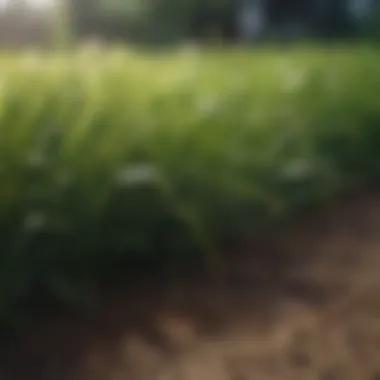Optimal Grass Seed and Soil Mix for Lush Lawns


Intro
Creating a lush, vibrant lawn is a goal that many homeowners aspire to achieve. However, the success of this endeavor is heavily reliant on the careful selection of grass seed and the quality of soil mix used. This article outlines critical insights regarding the optimal pairing of grass seeds and soil to maximize growth potential. We will delve into the varieties of grass suitable for various climates and the key factors affecting soil health, ensuring a comprehensive understanding for both novice and seasoned gardeners.
Whether you're picturing weekend gatherings on a soft, green lawn or simply desire a beautiful outdoor space, this guide serves to elevate your gardening skills. It is tailored to help you make informed decisions that cultivate thriving green areas you can be proud of.
Intro to Grass Seeding
Grass seeding is a fundamental process for anyone looking to achieve a beautiful lawn. It involves choosing the right grass seed and understanding the soil's composition that will support it. The first step is crucial, as poor seed selection can lead to uneven growth and a lackluster appearance. In contrast, high-quality seeds tailored to the climate can thrive, making your yard an attractive focal point.
Understanding grass seeding is essential not just for aesthetics but also for overall lawn health. There are various types of grass suited for different regions. Knowledge of these types enables homeowners to choose wisely based on their local environment. Additionally, the health of the soil plays a critical role in how well grass seeds will germinate and establish.
In this section, we will delve deeper into two key elements: the importance of grass seed quality and the overall health of the soil. By doing this, we aim to equip readers with a thorough understanding that can translate to successful lawn management.
Importance of Grass Seed Quality
The quality of grass seed is pivotal for establishing a resilient lawn. High-quality seeds grow into healthy, dense grass that can withstand common challenges such as pests, drought, and foot traffic. When selecting seeds, it is crucial to look for certified varieties that are disease-resistant and suited to your climate.
Seeds marked with a purity guarantee on their packaging ensure that they are true to strain and free from contaminants, which contributes significantly to successful germination and growth. Additionally, fresh seeds generally have a higher germination rate compared to older stock.
Factors to consider when assessing grass seed quality include:
- Seed origin: Local varieties tend to adapt better to regional conditions.
- Germination rate: Higher germination rates indicate better seed quality.
- Seed mix: Varieties blended correctly can provide a robust lawn, combining the strengths of different grass types.
Choosing the right quality grass seed cannot be overstated. Homeowners who invest time in seed selection often reap the rewards of vibrant and lush lawns.
Overview of Soil Health
Soil health is another foundational aspect of successful grass seeding. A rich, well-balanced soil environment supports grass growth from root development to nutrient extraction. Healthy soil is teeming with organisms that play roles in decomposition and nutrient availability.
Key indicators of soil health include:
- Organic Matter: Decomposed materials foster microbial life and improve aeration. Incorporating compost can enhance this component significantly.
- Inorganic Soil Content: Minerals in the soil, such as nitrogen and phosphorus, are vital for plant growth. Understanding the composition can inform fertilization as needed.
- pH Levels: Grass thrives within certain pH ranges. A soil test can reveal whether adjustments are needed to optimize grass growth.
Maintaining soil health requires constant attention and occasional amendments. This dynamic aspect of gardening is essential for sustaining the beautiful lawns many desire. In the following sections, we will explore different types of grass seeds suitable for various climates and how to select the appropriate soil mix.
Types of Grass Seeds
Understanding the types of grass seeds is integral to creating a healthy lawn. Each type of grass comes with unique characteristics that cater to different climate conditions, growth habits, and aesthetic preferences. Selecting the right variety has implications for the lawn's durability, maintenance needs, and overall appearance.
First, one must consider the climate. Cool-season grasses thrive in temperate regions with cold winters and moderate summers, while warm-season grasses flourish in areas with hot summers and mild winters. Choosing the suitable grass type impacts not only the visual appeal of the lawn but also its resilience against pests and diseases.
Cool-Season Grasses
Cool-season grasses are often preferred in states with colder climates. They grow during the cooler months, making them ideal for spring and fall planting. Their robust characteristics provide lush green lawns that are visually appealing.
Kentucky Bluegrass
Kentucky Bluegrass stands out for its rich color and ability to self-repair. This grass is notable for forming dense, lush turf that is soft and pleasant to walk on. Its ability to spread through underground rhizomes contributes to a thick lawn, which can withstand some wear and tear.
One of the key characteristics is its color. Kentucky Bluegrass typically has a vibrant green hue, which can enhance the overall beauty of your landscape. However, it might not be the best choice in areas with extreme heat or drought, as it requires regular watering and can struggle in high temperatures.
Tall Fescue
Tall Fescue offers a different set of advantages. It is known for its deep root system, which provides superior drought resistance. This means it can maintain its lush appearance even in less-than-ideal watering conditions. Its coarse texture is another defining feature, creating a hardy lawn suitable for both high foot traffic and moderate wear.


Tall Fescue is adaptable, making it a solid option for transitional zones. It grows well in both cool and warm seasons, providing flexibility in planting times. On the downside, its coarser blade texture may not be as aesthetically pleasing to some compared to finer grasses.
Perennial Ryegrass
Perennial Ryegrass is often favored for quick establishment. Its rapid germination allows for quick cover, making it an excellent choice for overseeding or filling bare patches in lawns. The seed germinates quickly, resulting in a lush and vibrant lawn that looks established sooner.
Characteristic of this grass is its fine and dense growth, which offers a lush appearance. However, it may require more frequent maintenance to look its best, especially in hot weather. It does not perform well in high heat or drought conditions, so it’s important to mix it with other grass types in warmer areas.
Warm-Season Grasses
Warm-season grasses excel in areas with hot summers. These grasses grow best in the late spring and summer months. They enter dormancy during the winter, making them suitable for southern climates.
Bermudagrass
Bermudagrass is widely recognized for speed and durability, especially in sunny landscapes. It establishes quickly and grows aggressively, making it ideal for high-traffic areas such as sports fields. Another strong point is its tolerance to heat and drought, which allows it to thrive in less-than-ideal watering conditions.
However, its invasive growth habit can lead to challenges. It may overtake neighboring plants if not contained properly, leading to undesirable effects in garden beds. Bermudagrass also demands regular mowing to keep it in shape and prevent it from becoming unmanageable.
Zoysia Grass
Zoysia Grass is valued for its thick texture and strong rooting system. This grass type is known for its ability to withstand heat, drought, and even some shade, making it versatile for many homeowners. Its brisk growth during warm months contributes to a dense lawn that can handle foot traffic well.
The downside is its slow establishment. Zoysia takes longer to fill in than other grasses, which can test the patience of eager gardeners. Once established, it requires less maintenance than more high-maintenance alternatives.
Buffalograss
Buffalograss is a native grass that is well-suited for arid regions. It is very drought-resistant, needing little water once established, which makes it an environmentally friendly choice for low-water lawns. Its fine texture is appealing, and it supports a diverse ecosystem of benefits for local wildlife.
However, its growth is not as robust as some other grass types. Buffalograss has a tendency to go dormant during extreme heat, leading to a brown appearance in varying conditions. This characteristic may be a consideration for those who prefer a consistently green lawn throughout the growing season.
Understanding Soil Components
Understanding the soil components is fundamental for creating a lush lawn. The relationship between soil quality and grass growth cannot be overstated. Healthy soil promotes nutrient availability, moisture retention, and overall grass vigor. This section explores key elements that contribute to soil composition, which will directly influence the success of your lawn.
Organic Matter
Organic matter refers to decomposed plant and animal material in the soil. It plays a crucial role in improving soil structure. A high organic content aids in moisture retention. It also enhances nutrient availability. As organic matter decomposes, it releases essential nutrients such as nitrogen, phosphorus, and potassium. Incorporating organic matter into your soil supports the growth of beneficial microorganisms. These organisms thrive in environments rich in organic material, thus fostering a healthier ecosystem.
- Benefits of Organic Matter:
- Improves soil aeration
- Enhances water-holding capacity
- Provides essential nutrients
Inorganic Soil Content
Inorganic content encompasses minerals and particles such as sand, silt, and clay. This component is vital for determining soil texture. The texture affects drainage, root penetration, and overall plant health. Sandy soils drain quickly but can lack nutrients. Clay soils retain water but can become compacted. A balance of these materials is key.
- Key Types of Inorganic Content:
- Sand: Drains quickly, good for aeration
- Silt: Retains moisture well
- Clay: High nutrient retention, but prone to compaction
pH Levels and Grass Growth
pH levels are critical in determining the availability of nutrients in the soil. Most grass species thrive in a pH range of 6.0 to 7.0. If soil pH is too high or too low, nutrient deficiencies can occur. Soil testing is essential to understand your lawn's pH level. If necessary, amendments can be added to adjust the pH. For instance, sulfur can lower pH, while lime can raise it. Keeping an optimal pH balance ensures that grass can absorb nutrients efficiently.
"Understanding the soil pH helps in nurturing a healthy lawn by ensuring that nutrients are available to the grass."
By comprehending the different soil components, homeowners can make informed decisions about lawn care. Investing time in soil quality will yield a vibrant and resilient lawn.


Selecting the Right Soil Mix
Selecting the right soil mix is crucial for developing a lush lawn. It acts as the foundation for grass growth, influencing how well the plants will thrive. The composition of the soil can determine moisture retention, nutrient availability, and root development. A carefully chosen soil mix forms a synergy with grass seeds, promoting healthy growth. Homeowners need to consider their local climate, grass type, and landscape conditions when selecting a soil mix.
Commercial Soil Mixes
Pre-formulated Mixes
Pre-formulated mixes are specifically created to cater to different types of lawns. They are designed to provide optimal nutrient levels and a balanced structure. The main characteristic of these mixes is their consistency in quality. This makes them a popular choice for homeowners who seek convenient solutions without extensive knowledge of gardening.
A unique feature of pre-formulated mixes is their ease of use. Homeowners can purchase them directly without the need to mix multiple components. However, one downside might be the cost, as these mixes often come at a premium price compared to DIY options.
Turf-Building Mixes
Turf-building mixes focus on creating a robust grass structure that can withstand wear. They usually contain higher amounts of organic matter and essential nutrients compared to standard mixes. This characteristic promotes sustainability and helps maintain a healthy lawn over time. Given their formulation, they are a beneficial choice for areas that receive heavy foot traffic, such as sports fields or family yards. A distinct advantage of turf-building mixes is their capability to self-repair. While they offer numerous benefits, one possible disadvantage could be that they require more frequent maintenance to keep up their nurturing aspects.
DIY Soil Mixture Techniques
Compost and Topsoil Blends
Compost and topsoil blends combine rich organic material with basic soil, enhancing overall soil quality. This technique contributes to better nutrient retention, improves moisture levels, and promotes microbial activity. The key characteristic of this blend is its natural ingredients, which appeal to environmentally conscious gardeners. It is a beneficial option for those looking to enhance the soil health at a lower cost. This blend's unique feature is the ability to enrich existing soil rather than replacing it entirely. However, the time needed to create compost might be a disadvantage for some homeowners.
Sand and Loam Combinations
Combining sand with loam creates a well-drained soil mix that prevents water logging while allowing roots to breathe. This is significant for climates with heavy rainfall or for lawns that may struggle with drainage. The mix's key feature is its balance of drainage and nutrient retention, making it a favorable option for many types of grass. Installing this combination provides the advantage of robust root growth, which is essential for a lush lawn. Nonetheless, the careful ratio of sand to loam must be observed to avoid overly sandy mixes, which might not hold nutrients effectively.
Timing Your Grass Seeding
Timing plays a crucial role in the seeding process for your lawn. It affects how well the grass establishes, its resilience against pests, and its growth rate. When you understand optimal seeding times, you can allow your grass to flourish under the right conditions, which leads to a healthy lawn.
Seeding at precise times also reduces the need for additional resources like water and fertilizers. A well-timed seeding ensures that the new grass gets the best chance to compete with weeds and adapt to its environment. Furthermore, this understand also helps homeowners plan other maintenance tasks around their lawn's growth cycle.
Seasonal Considerations
Different grass varieties thrive during particular seasons. For instance, cool-season grasses, such as Kentucky Bluegrass and Perennial Ryegrass, prefer the early spring or early fall for seeding. These grasses require cooler temperatures and adequate moisture to germinate, making the transitional seasons ideal.
In contrast, warm-season grasses, like Bermudagrass or Zoysia Grass, flourish during late spring and summer. Planting during these warmer months enhances their growth potential due to increased soil temperatures.
It is essential to consider the specific climate of your region when deciding when to seed. Failure to account for these seasonal differences can result in poor germination rates and weaker grass.
Weather Patterns Influence
Weather is a significant factor that impacts the timing of grass seeding. Rainfall can profoundly affect soil moisture levels, which are essential for seed germination. For example, if you seed just before a significant rainstorm, you may have a higher likelihood of success. However, planting during a dry spell can lead to insufficient hydration, hindering the seeds’ ability to sprout.
Temperature also plays a key role. Soil must reach a certain warmth to encourage germination of grass seeds. When soil temperatures are too low, grass seeds may fail to germinate or grow slowly. A period of consistent warm weather should be anticipated to maximize your chances of success.
Key Insight: Observing local weather forecasts can significantly help to make informed decisions regarding the timing of your grass seeding efforts.
Maintenance Practices for Lawns
Effective maintenance practices are crucial for ensuring a vibrant and healthy lawn. These practices not only promote growth but also enhance the resilience of grass against pests and diseases. Regular care techniques help maintain an ideal environment, keeping the grass lush and green. Understanding and implementing proper maintenance can drastically impact the longevity of your lawn.
Watering Techniques
Watering is a fundamental aspect of lawn maintenance. It is essential to provide an adequate supply of moisture to support grass growth. A common approach is to water early in the morning or late afternoon. This timing reduces evaporation and ensures the grass absorbs water effectively.
Some guidelines for effective watering include:


- Water deeply but infrequently. This encourages deep root development.
- Aim for about 1 to 1.5 inches of water per week, depending on climate and grass type.
- Check soil moisture with your finger. If the top inch is dry, it is time to water.
By following these watering techniques, homeowners can cultivate a stronger lawn that thrives in its environment.
Fertilization Strategies
Fertilization is vital for providing essential nutrients to grass. A proper fertilization program can improve color, density, and overall health. It is important to select the right type of fertilizer based on the specific needs of the grass and the soil composition.
Key points to consider when fertilizing include:
- Choose a balanced fertilizer with the right N-P-K ratio for your grass type.
- Apply fertilizer during the growing season for optimal results.
- Follow the recommended application rates. Over-fertilizing can lead to thatch build-up and nutrient run-off.
Routine fertilization can lead to improved growth and better resistance against environmental stresses.
Aeration and Thatch Control
Aeration is a technique that relieves soil compaction, improving root growth and moisture absorption. It involves perforating the soil with holes to allow air, water, and nutrients to penetrate deeper. This process is often beneficial for lawns that face heavy foot traffic.
In conjunction with aeration, addressing thatch is important. Thatch is a layer of dead grass and organic material that can suffocate your lawn if it becomes too thick. Here are strategies to manage thatch:
- Aerate the lawn at least once a year to break it up.
- Rake up excess thatch and consider using a dethatching rake or machine.
- Maintain proper mowing height and watering techniques to prevent excessive thatch build-up.
By implementing these methods, homeowners can cultivate a robust lawn that stands the test of time.
Managing your lawn through these maintenance practices is vital for achieving a lush and thriving yard.
Troubleshooting Lawn Issues
Lawn issues can arise from a variety of sources, impacting both the aesthetic and health of your green space. Understanding how to troubleshoot these problems is essential for maintaining a lush and vibrant lawn. Issues such as diseases, pests, and soil compaction can significantly hinder growth, necessitating prompt attention. By identifying and addressing these concerns, homeowners can ensure their lawns thrive.
Identifying Grass Diseases
Grass diseases can manifest in various ways, affecting the overall appearance and vitality of the lawn. Common symptoms include discoloration, irregular patches, and wilting. Proper diagnosis is crucial; without understanding the nature of the issue, treatment may be ineffective. Here are some prevalent diseases to watch for:
- Brown Patch: Appears as circular brown patches, often during humid conditions.
- Dollar Spot: Characterized by small patches that look bleached, common in high nitrogen settings.
- Powdery Mildew: A white powdery appearance occurs, especially in cool, wet periods.
Regularly inspecting your lawn and identifying these conditions early can mitigate damage. Consider using disease-resistant grass varieties as preventive measures. For further guidance, refer to resources such as Wikipedia.
Pest Control Measures
Unwanted pests can quickly become a serious issue for any lawn. Common invaders such as grubs, chinch bugs, and armyworms can destroy grass by feeding on the roots. Monitoring for signs of pest activity is vital to maintaining your lawn’s health. Effective pest control measures include:
- Regular Inspection: Spotting early signs of pest activity can save your lawn from extensive damage.
- Natural Remedies: Introduce beneficial insects such as ladybugs or utilize diatomaceous earth to manage pest populations.
- Chemical Treatments: As a last resort, pesticides can be employed, but should be used judiciously to avoid harming beneficial organisms.
Pest control is not merely about eradication, but establishing a balanced ecosystem where beneficial species thrive alongside your grass.
Addressing Soil Compaction
Soil compaction is a frequent issue that can stifle root growth, impede water penetration, and limit nutrient access. Compacted soil can result from heavy foot traffic or the use of heavy machinery. To alleviate soil compaction, consider the following techniques:
- Aeration: This involves perforating the soil with holes to relieve pressure and improve air circulation. Core aeration is particularly effective.
- Topdressing: Applying a thin layer of compost or quality soil mix can revitalize compacted areas, enhancing its structure.
- Regular Maintenance: Establish pathways or designated walking areas to minimize future compaction in vulnerable spots.
By taking proactive steps, you can maintain healthier soil, which in turn supports your grass’s growth and resilience.
Closure
In the scope of cultivating a lush lawn, the importance of an optimal grass seed and soil mix cannot be overstated. This article has delved into the various elements that contribute to successful grass seeding, from understanding different types of grass to the intricate details of soil health. Each aspect discussed plays a crucial role in the overall health and appearance of the lawn.
Grass seed quality has shown to be a vital factor. Selecting the right type, such as Kentucky Bluegrass for cooler climates or Bermudagrass for warmer regions, has direct implications on how well the lawn thrives. Moreover, an appropriate soil mix, blending organic matter with sand and loam, shapes not just the initial growth but the long-term sustainability of the turf.
Additionally, maintenance practices, such as effective watering techniques and fertilization strategies, can maximize the benefits derived from a well-selected soil mix. Addressing challenges like lawn diseases or soil compaction becomes easier with the right foundation in place.
"Choosing the right elements for your lawn is the first step to ensuring it flourishes for years to come."



